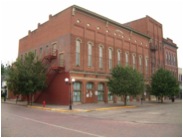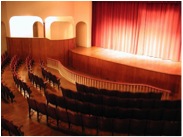Nelsonville

Current Name of Theater: Stuart’s Opera House
Current Type: annual Nelsonville Music Festival as well as over 75 other events a year which include live music, theatre, films, and educational programming
Web site: www.stuartsoperahouse.org
Historic Names of Theater: Stuart’s Opera House
Address 52 Public Square, Nelsonville, Ohio 45764
Year Built/Style: 1879
Seats: 395 capacity
Original Architect:
Original Cost: funded by George Stuart
Listed on National Register: yes 1979 – 78002007
Stuart’s Opera House is a registered historic building in Nelsonville, Ohio, listed on the National Register on December 29, 1978. It is an Opera House and live music performance theatre that was built in 1879, and continues to be used to this day.
History of Theater – please see below
Cost of Rehabilitation:
Sources of Funding:
Year of Rehabiliation: 1996/1997
Architect:
Contractors:

Renovation Story:
For more than 50 years, the opera house sat empty with no performances or activity, yet with all its scenery and theatrical equipment preserved. Then in 1976, the Hocking Valley Museum of Theatrical History, Inc (HV-MOTH), a non-profit organization, formed to restore and sustain Stuart’s Opera House as a viable theatre and cultural arts center.
On March 24, 1980, Stuart’s Opera House was the scene of a devastating fire that nearly destroyed the community’s hopes for its future. But after an extensive renovation and restoration project, including the complete reconstruction of the street level commercial space as well as the theater, Stuart’s reopened its doors in 1997.
History of Theater
Stuart’s Opera House is the cornerstone of the public square in Nelsonville Ohio and has been a part of this Southeast Ohio town since the boom times of coal mining in the 19th century. During this time, both the building and the region have gone through a great deal of change. Because of this, the history of Stuart’s can teach us about the transformations within Southeast Ohio, and particularly how the local population’s views on entertainment, and how to interact with the greater community, evolved.
The man who would build Stuart’s Opera House, George Stuart, began life in show business as the owner and operator of a showboat, traveling through the canal system of Ohio with a professional minstrel troupe. Stuart’s showboat sank in 1869 with construction of his new opera house beginning soon after.
Workers finished construction of the Opera House in 1879, at the start of Nelsonville’s boom period brought about by the growing rail system which sent coal from the area to the industrialized north. The presence of an Opera House signaled that Nelsonville had thoroughly established itself. The building quickly became a cultural centerpiece of the town, not only as a place of entertainment, but as a gathering place for community events: from benefits for local organizations and high school graduations, to Sunday school classes too large to fit in the local church. The Opera House attracted a high caliber of shows as well, playing host to some of the most successful acts of the era. The Opera House would continue to be deeply connected to Nelsonville until its closure in 1924, which was brought about in part by audiences’ preference for film and the coal boom coming to a halt.
Stuart’s doors would remain closed until the 1970’s when the Hocking Valley Museum of Theatrical History bought the building with the goal of restoring it to a working theater, as well as a place of learning. The hopes to restore Stuart’s were nearly dashed, however, when the building was enveloped in flames on March 24, 1980. What followed was great deal of heated debate over whether the building should be torn down, or if the restoration could start from scratch. In the end, it was decided that Stuart’s would be restored, and after an immense amount of money and effort, Stuart’s was finally ready to house an audience once more. The grand reopening on March 8, 1997 was headlined by Jack F. Spell’s performance of Ladies and Gentlemen: Mark Twain, a show written by Mr. Spell twenty years earlier, slated to open Stuart’s before the fire. And now, Stuart’s has once again prospered from humble beginnings. From a handful of community theater performances per year and a concert here and there, Stuart’s has become the premier performing arts center in Southeast Ohio. For the past 10 years the Opera House has seen growth, prosperity, culture and fun. In addition to a full concert schedule of the best in Americana, folk, and contemporary music, Stuart’s proudly hosts both community and professional theatrical productions, dance, and visual art exhibits. The atmosphere is so welcoming and intimate that you may just feel as if Lucinda Williams has come to your living room and is singing just for you. Volunteers, friends, patrons and donors agree that Stuart’s is where it’s at for music lovers and community.
Back in the mid-nineteenth century, Nelsonville native George Stuart’s showboat called the Arizona traveled on canals throughout Ohio with his minstrel troupe. In 1869, the Arizona sank in the Erie Canal during a rough storm. Stuart then returned to the booming coal mining town of Nelsonville with a dream of building an opera house to serve Nelsonville and Southeastern Ohio.
Envisioning a community-based arts center where first-class performances and community events could be staged, he built a magnificent theatre with bricks made by hand from a local surface clay.
The second-story playhouse called Stuart’s Opera House opened in 1879 and an article in the Athens Messenger called it, “…an ornament to the town and a monument to the public spirit of its projector.” During its glory, the opera house housed a variety of events including professional touring shows of vaudeville, musicals, minstrel shows, and melodramas, community theatre, meetings, high school graduations, recitals, religious events, and dances. Famous performers graced the opera house stage, including Elsie Janis known as “The Queen of Vaudeville,” vaudeville’s first great magician, Howard Thurston, and “Yankee Doodle Dandy” composer George M. Cohen. It was truly the focal point of all community activity. The theatre remained in operation until 1924.
![]()

